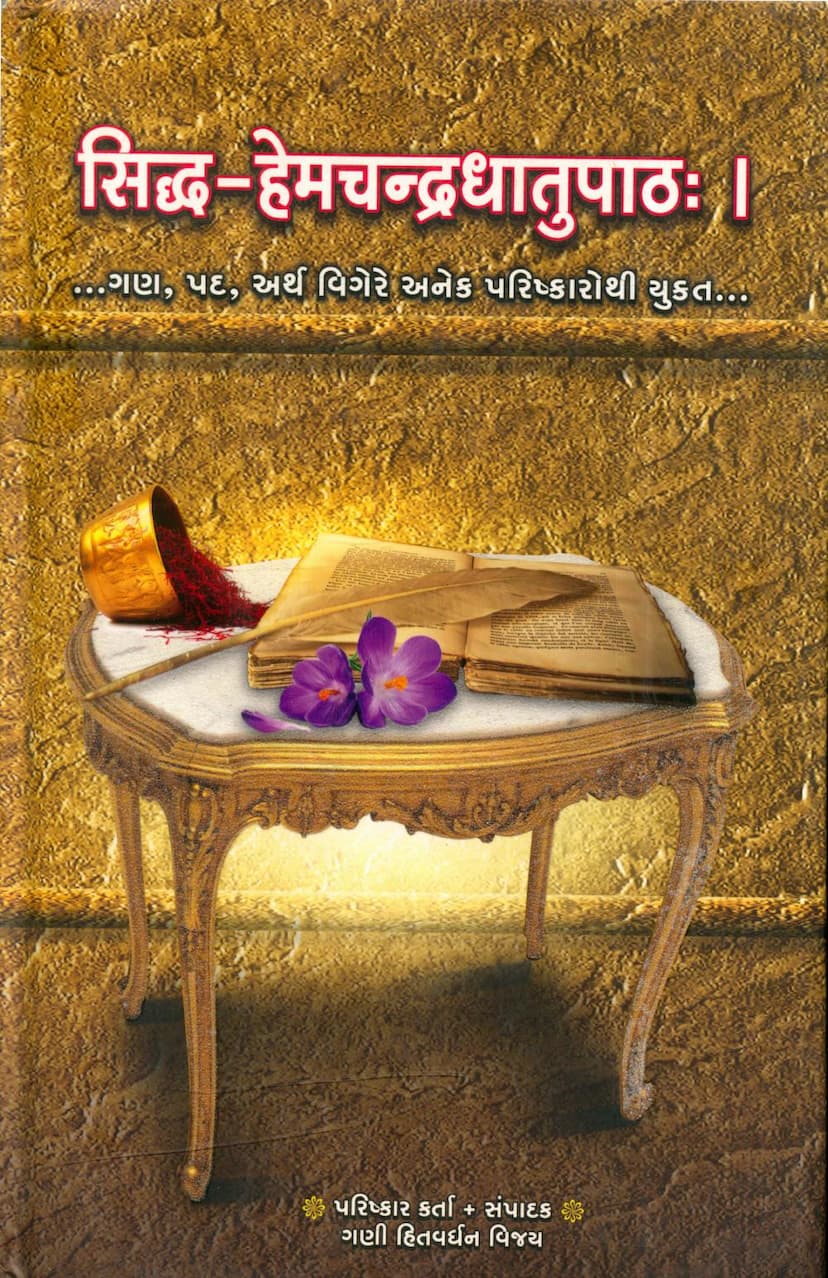Siddha Hemchandra Dhatupath
Added to library: September 2, 2025

Summary
The provided text is a Gujarati book titled "Siddha Hemchandra Dhatupath" authored by Hitvardhanvijay. It is published by Kusum Amrut Trust and is a commentary and compilation related to the grammatical concept of dhatus (roots of verbs) in Sanskrit, as presented in Hemachandra's renowned grammar, Siddha Hemachandra.
Here's a comprehensive summary based on the provided pages:
Core Purpose and Content:
- The book is a detailed presentation of the dhatupath (a systematic listing of verb roots) from the influential Sanskrit grammar text, Siddha Hemachandra, by Acharya Hemachandra.
- It aims to provide a comprehensive understanding of each of the 2050 recorded dhatus.
- The author, Ganivar Hitvardhanvijay, has enhanced the original dhatupath with several "parishkars" (refinements/additions).
Key Features and Refinements (Parishkars):
The book meticulously presents seven crucial pieces of information for each dhatu:
- The dhatu itself.
- Its meaning (Artha).
- Its gana (class of verb, e.g., 1st, 2nd, etc.).
- Its pada (personal ending – Parasmaipada, Atmanepada, or Ubhayapada).
- Whether it is Set (takes an augment like 'i') or Anit (does not take 'i'), or Vet (takes 'i' when followed by certain suffixes).
- The stem form of the dhatu used in conjugation, without any suffix.
- The stem form of the dhatu that receives an adesha (vowel/consonant change) if such a change occurs.
- The Gujarati meaning of the dhatu.
- The form of the dhatu in the present tense, third person, singular number.
Author and Lineage:
- The author, Ganivar Shri Hitvardhanvijayji, is a disciple of Pujya Gurudev Shri Bhavyavardhanvijayji M.S., who is a disciple of Pujya Acharyadevshri Nayavardhansurishwarji M.S., who in turn is a disciple of Pujya Acharyadevshri Ramachandrasurishwarji Maharaj. This lineage emphasizes his deep connection to Jain spiritual and scholarly traditions.
Inspiration and Motivation:
- The author shares his personal journey, recalling the struggles of learning Sanskrit grammar. He found immense benefit in memorizing the Siddha Hemachandra Dhatupath and concurrently developed these extensive notes.
- His primary motivation for publishing this work is to make this detailed information accessible and useful to other students, scholars, and researchers of Sanskrit.
Publication Details:
- Original Author of Dhatupath: Kalikal Sarvagnya Shri Hemchandracharya.
- Edition: 500 copies, First edition.
- Publication Date: V.S. 2072 (2016 CE), Ashadh Vad 14, Monday. This date coincides with the 25th Punyatithi (death anniversary) of Suri Ramachandra.
- Publishing Location: Navkar Aradhana Bhavan, Halol Jain Sangh, Halol, Gujarat.
- Publisher: Kusum-Amrut Trust, Shantinagar, Alkapuri, Vapi (Gujarat).
- Printing: Tejas Printers, Ahmedabad.
Financial Aspects:
- The book is largely financed by "gyanadravya" (funds dedicated to knowledge dissemination).
- It is available for ₹240, with a suggestion for those wishing to study it to register their usage with the "gyankhata" (knowledge fund).
- The publication received significant support from the Shree Shankheshwar Mahatirth and was a joint effort of Shree Shantinagar Jain Sangh, Vapi, and Shree Navkar Aradhana Bhavan, Halol Jain Sangh, utilizing funds generated during a Chaturmas.
Additional Content:
- The book includes devotional hymns (stotras) in praise of Jain Tirthankaras and his spiritual preceptors, such as Shree Shankheshwar Parshvanath and Acharya Ramachandra Surishwarji Maharaj.
- It also features commendations and reviews from other respected Jain scholars and monks, praising the author's effort and the book's utility.
- The latter part of the document (from page 19 onwards) shows a detailed breakdown of the dhatus by gana (class), with the dhatu, its meaning, gana, pada, Set/Anit status, stem, and Gujarati translation of the meaning provided for each. The listing seems to be extensive, covering thousands of dhatus across the ten ganas.
In essence, this book is a scholarly and devotional work that significantly enhances the study of Sanskrit grammar by providing a more accessible and detailed presentation of Hemachandra's dhatupath, making it a valuable resource for Jain scholars and students.